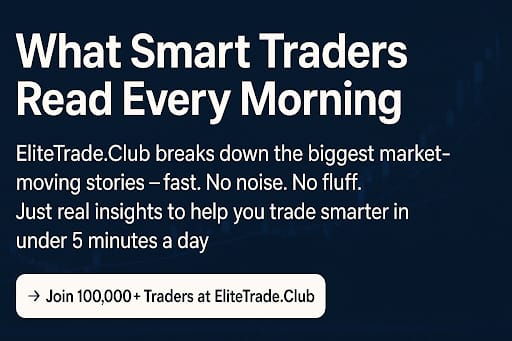- Analyzed Investing
- Posts
- Tariff Tsunami: When Politics Hijack the Market
Tariff Tsunami: When Politics Hijack the Market
New tariffs hit core industries, Fed credibility erodes, and risk spreads quietly widen. Markets are chasing AI while ignoring the storm forming beneath.

Missed the Market’s Big Moves?
The market moves fast - we make sure you don’t miss a thing.
Elite Trade Club delivers clear, no-fluff market intel straight to your inbox every morning.
From stocks to big-picture trends, we cover what actually matters.
Join 100,000+ readers who start their day with the edge.
🌊 Tariff Tsunami: Politics as Monetary Policy
This week, the U.S. didn’t just raise tariffs—it raised the stakes. The so-called Liberation Day tariffs rolled forward on August 7th, targeting semiconductors, pharmaceuticals, and critical minerals. These aren’t fringe industries. They are the nervous system of modern economies: the chips in your phone, the medicines in your cabinet, the cobalt in your batteries.
The political line? Protect American workers.
The economic reality? A hidden tax on consumers.
Tariffs drive prices up, full stop. When inputs rise—whether that’s chips, chemicals, or metals—costs cascade through supply chains until they land on store shelves. The same groceries, gadgets, and cars will cost more. And in a consumer-driven economy, that matters.
Markets shrugged at first. After all, equities have learned to live with chaos as long as AI earnings stay bright. But tariffs are different. They don’t just dent corporate margins—they fracture the global trading system. Retaliation is inevitable. Europe is already whispering counter-tariffs. China’s response may not be loud, but it will be surgical—targeted at industries America can’t afford to lose.
This isn’t protectionism. It’s economic trench warfare.
🏛 The Fed Under Siege
The tariffs are bad enough. But the real danger is what they represent: the accelerating politicization of the Federal Reserve.
For months, political pressure on the Fed has been building. Key appointments dangled, leadership threatened, independence questioned. The central bank—once the most untouchable institution in the U.S.—is now being pulled into the partisan arena.
Layer tariffs on top, and the Fed’s job becomes nearly impossible. Tariffs stoke inflation in the short run, but political leaders don’t want rate hikes before an election. That sets the stage for the worst possible dynamic: rising prices, but pressure to cut rates anyway. In effect, politics hijacks monetary policy.
And when markets realize that the Fed is no longer truly independent, risk premia won’t stay quiet. Investors demand higher yields for U.S. debt when credibility slips. That flows into mortgages, corporate bonds, and equity multiples. In short: the cost of capital rises.
The irony? By weaponizing tariffs and undermining the Fed, policymakers may end up choking off the very growth they claim to defend.
📉 Markets Caught in the Middle
So where does that leave investors? Stuck between two illusions.
On one side, Wall Street clings to the AI trade, extrapolating Palantir’s earnings beat into a story of endless growth.
On the other, Washington insists tariffs and political meddling are a “necessary reset” for America’s economy.
Both are partial truths, wrapped in spin. AI is real, but valuations are stretched to a breaking point. Tariffs may help some domestic producers, but the broader economy pays the bill.
Markets are trying to hold both ideas at once: tech will soar, and tariffs will be painless. History says they can’t both be true.
This is why spreads are widening quietly, why defensive sectors are seeing inflows, and why volatility—despite plunging this week—feels less dead and more suppressed. Beneath the surface, the system is creaking.
🔍 What This Means for Investors
Investors need to stop treating the market like a monolith. In this environment, dispersion is everything. Some sectors—defense, energy, selective tech—may thrive even in turbulence. Others—import-reliant industries, consumer discretionary, leveraged growth—will struggle as tariffs filter through and financing costs rise.
That means defensive positioning isn’t optional—it’s survival. Companies that provide essential goods and services—consumer staples, healthcare, utilities—become more valuable when uncertainty rules. Not because they offer explosive upside, but because they preserve capital when everything else is cracking.
One systematic way investors approach this is by building baskets of recession-resistant names. These aren’t glamorous. They’re not chasing the AI trade or promising quantum breakthroughs. They’re the businesses people still buy from when times are tough—groceries, medicine, power. Allocations into that kind of portfolio don’t eliminate risk, but they cushion the blow when volatility returns.
It’s the same principle at play across cycles: when politics hijacks the Fed, when tariffs weaponize supply chains, when growth is an illusion, the only thing that matters is durability.
Final Take
This week was a case study in illusions. The illusion that GDP is booming, when demand is barely crawling. The illusion that tariffs are protection, when they’re really consumer taxes. The illusion that the Fed is in control, when politics has already breached the walls.
Markets love illusions because they keep the party going. But investors who build around illusions are the ones left holding the bill when reality breaks through.
The prudent approach now isn’t chasing headlines. It’s preparing for the hangover.
Not Financial Advice. This newsletter is for informational and educational purposes only. It does not constitute investment, legal, or tax advice. The opinions expressed are solely those of the author and do not reflect the views of any affiliated organizations or institutions. Please consult a licensed financial advisor before making any investment decisions.
